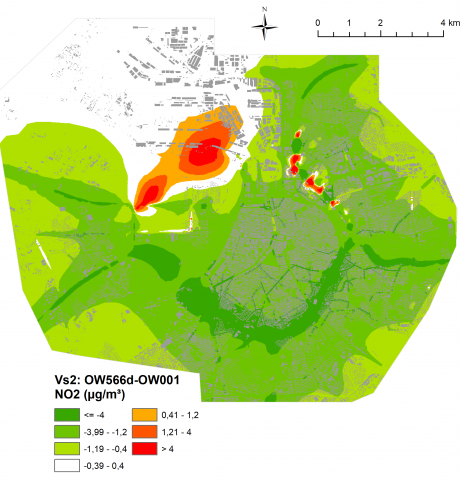User story: Role of supercomputing in High-Resolution Air Quality Modelling for the Oosterweelverbinding

Illustration above shows the difference in NO2 [2] concentrations between two possible scenarios that were calculated (see moderating measures in report p.106-122 via https://bit.ly/3JnNm8h)
The Oosterweelverbinding project was set up to improve the accessibility to the port and the city region of Antwerp by completing the ring road around Antwerp (R1) on the north side. Wouter Lefebvre, researcher at VITO explains how HPC infrastructure was indispensable in providing the calculations for the high-resolution air quality modelling for the Environmental Impact Assessment Report [1] in the context of the Oosterweelverbinding.
Environmental impact assessment report for the Oosterweel
 As an independent Flemish research organisation in the field of cleantech and sustainable development VITO provides services and instruments to support governments, industry and the private sector in their decision making. BAM (now Lantis), the constructor of the Oosterweelverbinding, asked VITO in the run-up to the project to do the calculations for the Environmental Impact Assessment report for the domain ‘air quality’. In this report the effects of the project on air quality had to be simulated: for example, what would the impact be on the concentration of air pollutants if a tunnel was placed on a certain location or if a road link was covered or not and how would this be reflected in air quality. The impact on the air quality was visualised using high resolution air quality maps.
As an independent Flemish research organisation in the field of cleantech and sustainable development VITO provides services and instruments to support governments, industry and the private sector in their decision making. BAM (now Lantis), the constructor of the Oosterweelverbinding, asked VITO in the run-up to the project to do the calculations for the Environmental Impact Assessment report for the domain ‘air quality’. In this report the effects of the project on air quality had to be simulated: for example, what would the impact be on the concentration of air pollutants if a tunnel was placed on a certain location or if a road link was covered or not and how would this be reflected in air quality. The impact on the air quality was visualised using high resolution air quality maps.
Air quality modelling
To make assessment maps VITO uses the in house developed ATMO-Street air quality model. Via traffic modelling and the average composition of the vehicle fleet, a good estimation of traffic-based emissions can be made per road (segment) for a time period of one year. The emission data is then processed by a computer using the air quality model. This software calculates how air pollutants are spread considering meteorological data such as wind speed, wind direction and temperature resulting into a map with points. Via interpolation techniques VITO makes a high-resolution map illustrating the concentration of air pollutants. In this case different pollutants were calculated (e.g. NO2 [2], PM10, PM2.5 [3]). To produce the high-resolution air quality maps for the Oosterweel project VITO used two different air quality submodels of the ATMO-Street modelling chain: IFDM [4] (developed by VITO) and OSPM (in license from Aarhus University). The model is flexible; as a result, the effect on the air quality of possible policy decisions, for instance, on the number of electric vehicles, can also be simulated.
Significant increase of calculation speed thanks to HPC
Modelling air quality at a high-resolution requires a lot of computer resources (CPU [5] , storage and memory). Calculations have to be made for each hour in a year which requires a lot of computation time. In addition, for the environmental impact assessment report not only the planned situation for Oosterweel had to be calculated but also a large number of alternative scenarios. Each scenario required a new calculation which on normal computer infrastructure would have been very time consuming.
Wouter Lefebvre (VITO): “The large number of scenarios and the detail of the air quality modelling was too overwhelming for the computer infrastructure of VITO. By using HPC-infrastructure (VSC Tier-2 infrastructure) more calculations could run in parallel, that way the amount of calculations was taken care of easily. Thanks to the HPC-infrastructure we were able to get the necessary detail in the air quality maps at a sufficient tempo.”
Assessment delivered within allocated time
An environmental impact assessment report has to be delivered to obtain an environmental permit. As no building can be done before the permit is delivered, the timing of the environmental impact assessment report is crucial. Therefore, analyses had to be delivered within certain deadlines. Thanks to the use of the VSC HPC-infrastructure VITO was able to deliver the calculations for the environmental assessment within the allocated time without any delay.
High service level
"I also was pleased with the service level when using the HPC-infrastructure. When problems were encountered, we could always turn to the helpdesk and problems were solved quickly."
- [1] Environmental Impact Assessment Report: MER (Milieueffectrapport).
- [2] NO2: Nitrogen dioxide, a gas produced by combustion engines and a health concern.
- [3] PM2.5: Particulate matter (PM) denotes all small solid and liquid particles that float around in the atmosphere. In this case, it is all particles below 2.5 µm.
- [4] IFDM:The IFDM (Immission Frequency Distribution model) calculates the impact of emissions of point sources (for example a factory chimney) and line sources (traffic on a road) in the immediate surroundings of that source. However, this model does not consider shielding by buildings, screens, slanting or other elements that obstruct free air circulation. Therefor the IFDM model was combined with the OSPM model, which does allow to refine the modelling in dense built environments to street canyon level.
- [5] CPU: Central Processing Unit, more information on the Glossary Vlaams Supercomputer Centrum.
About Wouter Lefebvre
 Wouter (born in 1982), obtained his master in physics in 2003, a DEA (diplôme d’études approfondies en sciences physiques) in 2004 and his PhD in physics in 2007. In the process he has gained experience in climate and meteorology modelling. In 2008 he joined the Modelling of Atmospheric Processes group at VITO. Since then he has taken part in several projects concerning modelling of air quality from the regional to urban micro-scale. He is an expert in the air quality studies involving the IFDM-model (e.g. heavy metal disposition and various Hot Spot studies). He is also author of the book ‘Onze lucht’ and recognized MER-expert air.
Wouter (born in 1982), obtained his master in physics in 2003, a DEA (diplôme d’études approfondies en sciences physiques) in 2004 and his PhD in physics in 2007. In the process he has gained experience in climate and meteorology modelling. In 2008 he joined the Modelling of Atmospheric Processes group at VITO. Since then he has taken part in several projects concerning modelling of air quality from the regional to urban micro-scale. He is an expert in the air quality studies involving the IFDM-model (e.g. heavy metal disposition and various Hot Spot studies). He is also author of the book ‘Onze lucht’ and recognized MER-expert air.